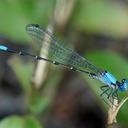United States and Canada
The head of the male is pale blue anterior to the ocelli and black behind the ocelli with a stripe extending forward to the base of each antennae. The pale blue occipital spots are sometimes connected. The lower lateral third and ventral parts of the pterothorax are pale yellow becoming pruinose and obscured with age. The black thoracic markings however are never obscured. The middorsal carina is narrowly outlined with black. The humeral suture is a hairline black stripe widening above and below, but more so anteriorly. The legs are pale, darkly marked with black on the outer surfaces of the femora and the inner surfaces of the tibiae and tarsi. The abdominal color pattern is black dorsally on segments 1-7, except for pale blue basal rings on segments 3-7. Segments 8-10 are uniformly pale blue over their entire length. The ventrolateral areas of these segments are black. The cerci are short and blunt when viewed laterally, but when viewed posteriorly two decurved hooks are visible. The paraprocts extend out beyond the cerci, but both are shorter than or subequal in length to segment 10. The paraprocts are distinctly bifid. The head of the female is similarly colored to the male. The dark humeral stripe is usually thin, as in the male, but occasionally it may extend to the mesepimeron. The mesostigmal plates lack posterior lobes, but when viewed laterally the anterior carina is usually visible. Mesepisternal tubercles are small or lacking. The legs are similarly colored to the males. The abdominal color pattern is similar to the male, but often with more extensive black markings. Segments 8-10 are black dorsally, each with a dark dorsolateral stripe.
Size: Total length: 33-40 mm; abdomen: 26-32 mm; hindwing: 21-25 mm.
Similar Species (south-central US): Blue-tipped Dancer (A. tibialis) has abdominal segment 8 black.
Female Powdered Dancers (Argia moesta) look very similar to female Blue-fronted Dancer (Argia apicalis), but are larger. Female Powdered and Blue-fronted Dancers can be separated by the pattern on the side of S9: Powdered has pale sides, whereas Blue-fronted has a dark stripe.
All other dancers will have a broader middorsal thoracic stripe.
Habitat: Large rivers and occasionally streams, lakes or ponds.
Natural History: A study of a population of this species, residing at a small pasture pond in Marshall County, Oklahoma, found that males and females reached reproductive age at an average of 8.4 and 7.0 days, respectively with maximum activity occurring at noon. Males were at the water 44% of the days they lived and females only 20%; however, males only mated on 20% of these days and females 89%. Repeat matings, in both sexes, were rare. The movement from roosting sites to the water was characterized by a random shifting, with males arriving at the water earlier than females and spacing themselves at six-foot intervals. Mating occurred a short distance from the main concentration of males and lasted 16 minutes. Females were gregarious laying eggs, either in tandem (75% of the time) or alone, in willow roots, boards and sticks. Further study revealed that males occurred in two color phases: bright blue and a gray-black, and that color change could not be correlated positively with age or reproduction. In the same study, females occurred in three color phases: brown, turquoise and gray-black. Further observations in the field have revealed that the gray-black phase is a temporary color change that occurs during mating and at cool temperatures. Males live more than a month and exhibit intra- and interspecific competition, flicking their wings as a warning to intruders in their territory. On hot days they thermoregulate by raising their abdomen to a 60B0 angle, reducing the surface area exposed to the sun. Variable thoracic stripe patterns are seen in individuals along the periphery of the species' southeastern distribution, with both a broad-striped form, having a wide full-length humeral stripe, and the more typical form with a reduced pattern, as seen in the s outh-central United States.
Distribution: Generally east of the Rocky Mountains from Florida to Ontario, but also known from eastern Arizona.
Source: Abbott, J.C. 2006-2010. OdonataCentral: An online resource for the distribution and identification of Odonata. Available at OdonataCentral.
Edited by Drew Weber (9/24/2015). Edited by David Bell (07/20/2016).
